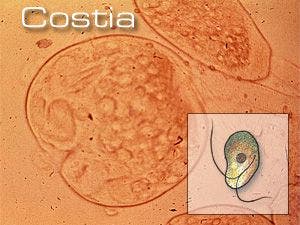Costia

Ichthyobodo necator (Costia)
This koi parasite is extreamly small (10-20 microns long) and a magnification of 100 times is the absolute minimum required to identify costia, 400 times is ideal. When taking a skin scrape and looking for Costia, try to avoid using a thick layer of mucus and add a drop or two of water to the slide. Costia is a very fast moving parasite and looks in shape similar to a comma, search the entire slide carefully but you will often find it easiest to identify this parasite along the edge of the mucus layer where this meets water.
Costia affects both the skin and gills of koi, and left undetected will multiply at an alarming rate and can soon cause mortalities of koi.
Symptoms of infection include excess mucus production, respiratory distress, and general debilitation, the eyes of your koi may also appear sunken.
The koi parasite Costia has a very simple life cycle, using a process known as binary fission, meaning each parasite divides into two.
Costia infestations can be treated using a mixture of Malachite Green and Formaldehyde at the same dose rate as described above for white spot. Another effective treatment is potassium permanganate
Costia is a minute Flagellate with 3-4 flagella. It affects both the skin and gills of Koi, and reproduces itself by binary fission. Infestations of this parasite can appear very rapidly indeed, and Koi suffering infestations exhibit the classic symptoms of lethargy, clamped fins, rubbing and flashing and the skin can take on a grey white opaqueness.
Costia normally only affects fish that have already been debilitated by some other cause, and can often be seen on Koi as a secondary parasite.
Remember a high magnification must be used to view these parasites (400 x) and staining is recommended for positive identification.


